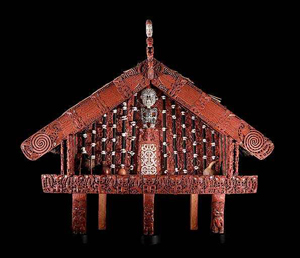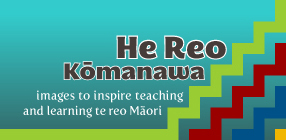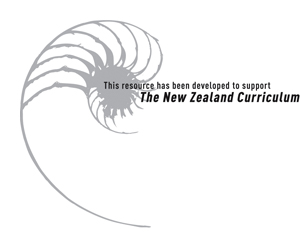
ImageTeaching and learning sequenceAdditional tasks and activities
Sample task sequence 4: Te Tākinga, pātaka
Digital resource from the Te Papa Collection
Image: Te Tākinga, pātaka (storehouse) c. 1850


Copyright: Reproduced courtesy of the Museum of New Zealand Te Papa Tongarewa
Creator: Te Hāreti Te Whanarere, artist, c1850, Thomas Herberley, designer, 1930s
Identifiers: Museum of New Zealand Te Papa Tongarewa number ME015723. TLF resource R3687
Source: Museum of New Zealand Te Papa Tongarewa, http://www.tepapa.govt.nz
Students should be able to (4.5) communicate about the quality, quantity, and cost of things.
Links to other learning areas
Arts (visual arts), technology, history
Te reo Māori text
**Nō wai rā? Nō wai rā? Nō wai hoki te taonga nei e whakaatu ātaahua mai ana ki te ao hou? Nō te iwi o Ngāti Pikiao, i te rohe o Te Arawa. I tapaina ki te ingoa Te Tākinga. Ko tērā hoki tō rātou tipuna rongonui. Ko ia hoki i whakairotia te tekoteko i mua mai o te whare nei.**
Heoi anō ko ngā whakaaro nui ki a Te Hāreti Te Whanarere o Ngāti Makino, nānā hoki i hanga, i whakairo taua pātaka. Engari anō, nā te tawhito haeretanga, nā Thomas Heberley o Te Atiawa i whakatika ētahi wāhanga o te pātaka i ngā tau 1930-1938. Ki te hunga mātaki, ka kitea tēnei pātaka e tū ātaahua mai ana i te whare o Te Papa Tongarewa i te Whanganui-a-Tara.
**The asterisks denote the beginning and end point of the text that will be used for grammar dictation. (See item 4 in the teaching and learning sequence.)
Teaching and learning sequence
When appropriate, the teacher shares the intended learning outcomes with the students and negotiates success criteria with them. The teacher and students discuss these throughout the teaching and learning sequence.
1. Viewing of image
The students view the image: Te Tākinga, pātaka (storehouse) c. 1850.
2. Pre-reading discussion
The students work in pairs or groups of four, discussing the image and sharing their ideas and opinions about it. If discussion in te reo Māori is beyond them, they could conduct their discussion mainly in English and make a word bank of relevant te reo Māori vocabulary. The teacher then leads a class discussion and records key new te reo Māori vocabulary to create a class word bank. The word bank includes the names Ngāti-Pikiao and Te Tākinga and the unfamiliar word “tapaina” in order to support the students in the listening task that follows.
3. Reading te reo Māori text
The class conducts a Grammar Dictation task for the first paragraph of this text (marked by double asterisks). For this task, the students work in groups of four. The teacher twice reads the first paragraph of the text, clearly and at normal speed. The first time the text is read, the students just listen carefully and try to grasp the gist of the information. The second time, they listen and note down keywords only. (The teacher advises them beforehand that they will not have time to write full sentences.)
The students then work in their groups to share and discuss the words they recorded and everything they remember about the text that was read to them. They use this information as they work together to reconstruct the text. They endeavour to include all the information from the text and to write in grammatically accurate sentences, but they do not need to write in exactly the same words as the text. The teacher circulates, encouraging the students and checking that they understand the process. The reconstruction of the text is likely to take about 20–25 minutes.
After this time, each group writes their reconstructed text on the board, sentence by sentence, and the class compares all the versions and discusses the differences. The students then compare their texts with the original and discuss whether all the essential information was included in each group’s version.
4. Teacher clarification
The teacher draws the students’ attention to new vocabulary and grammar and clarifies meaning where necessary.
5. Further reading and discussion
The students read the second paragraph of the text individually, discussing any difficulties within their groups. After the reading, the teacher again checks the students’ understanding and clarifies any new grammar points within the second paragraph.
6. Group mind mapping
Working in groups of four, the students make a mind map of what they have learned about Te Tākinga. This mind map is kept safe, as it will be used later, with additional information, in the presentation.
7. Inquiry
Facilitated by the teacher, the students discuss what other information they want to find out about pātaka. Topics for the inquiry might include:
- The design features of pātaka and the reasons for them (for example, the reasons for their being elevated)
- The items that were stored in different types of pātaka
- Other methods of storing food in the past and the technologies that were used.
Each group forms a written question on which to focus their inquiry and then each student makes an inquiry plan that identifies how they will seek answers to their question. This might be through reading (using the library or Internet), museum visits, or interviewing whānau members or kaumātua. While the teacher provides support and oversight, the students undertake at least part of their inquiries for homework. They make written notes in which they record keywords and simple sentences in te reo Māori, and they bring these notes to school.
8. Addition of information to group mind maps
The class discusses the criteria for an effective mind map. Then, in their groups, the students pool the results of their inquiries and discuss how their findings can be incorporated into their group mind maps. This involves group discussion and the synthesis, prioritisation, and organisation of information. As the students work, the teacher circulates, helping with vocabulary and encouraging the students to kōrero Māori.
9. Presentation
The teacher selects a method of presentation, perhaps choosing from one of the five suggestions in this resource.
10. Reflection
The students have 10 minutes to reflect individually on what they have learned from this cycle of learning. They briefly record the following information in te reo Māori:
- Tuhia ngā kupu hou. (List the new vocabulary you learned.)
- Tuhia tētahi whakaaro hou i akongia e koe. (Write one new thing you learned from your own inquiry.)
The students follow this with pair reflection, and then class reflection, about the new language forms they learned during this teaching and learning sequence. The teacher encourages them to consider whether they felt confident about using the new language, and whether they feel their goals were met. The students finish by setting personal and class goals for the next sequence of teaching and learning.
Additional tasks and activities
Depending on their students’ needs and interests, teachers may like to select from some of the following tasks and activities:
- Make a study of the whakairo on Te Tākinga, and make comparisons with whakairo on students’ own wharenui or other traditional pātaka or whare they have seen.
- Create whakairo patterns. If carving facilities are not available, the patterns could be drawn on paper.
- Search the Internet for other examples of whakairo Māori.
- Explore the images of whakairo and try some of the suggested activities in the Ministry of Education (2004 and 2007) resources on Māori visual culture.
- Make comparisons between whakairo Māori and whakairo from other Pacific nations.


